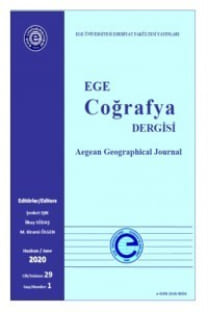İZMİR-BOZDAĞLAR YÖRESİNİN YAPISAL JEOMORFOLOJİSİ VE EVRİMİ
Klâsik anlamda bir sınırlandırmaya bağlı tutulmayan bu sahanın sınırı Küçük Menders nehrinin doğuş havzası ile Alaşehir ovasının doğusu arasında izafi olarak çizilen hat üzerinden geçirilmiştir. Kuzeyde Alaşehir çayı-Aşağı Gediz nehri mecrasını izleyen sınır, kuzeybatıda Manisa dağı- Yamanlar dağı doruk hattı üzerinden İzmir körfezi çukuruna ulaşır. Güneyde ise bu sınır, Kiraz ilçesi yakınlarından başlayarak batıya doğru uzanan mesafede Küçük Menderes nehri yatağını izler ve Çevlik deresinin Küçük Menderes nehrine kavuştuğu yerden itibaren Cumaovası’mn bir bölümünü içte bırakarak batıdaki az yüksek tepeler üzerinden İzmir körfezine bağlanır. Bu yazıda, yukarıda belirlediğimiz sınırlar içerisinde kalan sahanın yapısal özelliklere ve genç tektonik hareketlere bağlı olarak oluşan morfolojik görünümünün evrimini açıklamaya çalışacağız.
Anahtar Kelimeler:
-
The structural geomorphology of the İzmir-Bozdağlar region and its evolution (Western Turkey)
In this study we investigated the structural features which have been developed under the effects of the tectonic movements and external forces during the Neogene and Quaternary periods in İzmir Bozdağlar and its surroundings. We divided the study area into five structural feature parts. The first part which extends from the east to the west in the midpart of the area is Bozdağlar metamorphic massive, and is composed of gneiss, quartzite, mica schist, phyllite and marble.Izmir-Manisa Mesozoic flysch zone is the second part, situated on the western side of the Bozdağlar massive and extends from southwest to the northeast. This zone is composed of clay-schist, sandstone, conglomerate, limestone, and some volcanic rocks.Neogene and Tmolosschutt or Plio quaternary clastic deposites which were derived from the Bozdağlar massive are found on the northern and southwestern parts c r the given area. As a result of the tectonic movements there are some alluvial basins among the large structural features surrounded by high places, for example Bornova plain, Küçük Menderes and Lower Gediz River basin. There are some volcanic formations in the western part of the given area. Some of these are in tho Mesozoic zone or volcanic forms been built separately.The study area has a complex evolutionary history. The tectonic movements and erosional factors have played an important role in this evolution. During the cycle o'" the Middle/Upper Miocene the local tectonic influences had developed Gediz, Bornova and Cumaovası basins independently. Because Western Anatolia massive (or Menderes massive) dissected by the faults and the present Bozdağlar metamorphic chain, Manisa dağı and Nif dağı uplifted as horsts and Bornova, Cumaovasi end Lower Gediz depressed as grabens. The mountains in the area had been eroded according to the base level of the Neogene lakes in which sediments material were accumulated during the Neogene and Plio-quatenary periods.ln the Pliocene cycle as a result of the tectonic movements the mountain blocks had rised and basins had become depressed again. The depositional formations of Miocene had faulted. Under the effects of the cooler, humid and semiarid climate conditions during the course of the period some fine grained reddish, Brown coloured and some clastic sediments had filled in the Lower Gediz basin and Bornova and Cumaovası plains. At the end of the period some later local tectonic movements had taken place and Küçük Menderes basin had developed. In the cycle of Pleistocene at first Gediz and Cumaovası basins and later Küçük Menderes depression had been captured, and Bornova basin had sinked on the West part. The outline of the drainage systems of the area had been established and under the effects of the Pleistocene periodic pluvial fluctuations the sediment formations in the basins had been eroded by the rivers of the area.
Keywords:
-,
- Yayın Aralığı: Yılda 2 Sayı
- Başlangıç: 1983
- Yayıncı: Prof. Dr. Şevket IŞIK
Sayıdaki Diğer Makaleler
İZMİR-BOZDAĞLAR YÖRESİNİN YAPISAL JEOMORFOLOJİSİ VE EVRİMİ
PROF. DR. İSMAİL YALÇINLAR’IN MESLEK YAŞAMI VE TÜRKİYE JEOLOJİSİ İLE FİZİKİ COĞRAFYASINA KATKILARI
BAKIRÇAY DELTASI'NIN ALÜVYAL JEOMORFOLOJİSİ
THE ECOSYSTEMS OF NORTH EASTERN ANATOLIA
İbrahim Atalay, Mehmet Tetik, Özer YILMAZ
IŞIKKENT-PINARBAŞI SANAYİ BÖLGESİ (İZMİR): BİR EKONOMİK COĞRAFYA ARAŞTIRMASI
BOZCAADA'NIN FİZİKİ COĞRAFYASI
